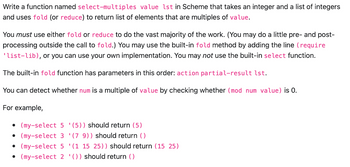
Computer Networking: A Top-Down Approach (7th Edition)
7th Edition
ISBN: 9780133594140
Author: James Kurose, Keith Ross
Publisher: PEARSON
expand_more
expand_more
format_list_bulleted
Question
Using Scheme:

Transcribed Image Text:**Title: Creating a Function to Select Multiples in Scheme**
**Objective:**
Learn how to write a function named `select-multiples` in Scheme that processes an integer and a list of integers. The function will utilize `fold` (or `reduce`) to return a list of elements that are multiples of the specified integer.
**Instructions:**
1. **Function Requirements:**
- Create a function `select-multiples value lst`, which uses `fold` or `reduce` to determine multiples of `value` in the list `lst`.
2. **Constraints:**
- The vast majority of the work should be handled by `fold` or `reduce`. Minimal processing is permitted outside the `fold` call.
- You may add the line `(require 'list-lib)` to access the built-in `fold` method.
- Do not use the built-in `select` function.
3. **Understanding `fold`:**
- The `fold` function parameters are ordered as follows: `action partial-result lst`.
- You need to identify if `num` is a multiple of `value` by verifying if `(mod num value)` equals 0.
4. **Examples:**
- `(my-select 5 '(5))` should return `(5)`
- `(my-select 3 '(7 9))` should return `()`
- `(my-select 5 '(1 15 25))` should return `(15 25)`
- `(my-select 2 '())` should return `()`
This approach emphasizes functional programming concepts, particularly leveraging higher-order functions like `fold` to simplify data processing tasks in Scheme.
Expert Solution
arrow_forward
Step 1
So below the function is implemented below in Scheme
Step by stepSolved in 3 steps with 2 images

Knowledge Booster
Similar questions
Recommended textbooks for you
 Computer Networking: A Top-Down Approach (7th Edi...Computer EngineeringISBN:9780133594140Author:James Kurose, Keith RossPublisher:PEARSON
Computer Networking: A Top-Down Approach (7th Edi...Computer EngineeringISBN:9780133594140Author:James Kurose, Keith RossPublisher:PEARSON Computer Organization and Design MIPS Edition, Fi...Computer EngineeringISBN:9780124077263Author:David A. Patterson, John L. HennessyPublisher:Elsevier Science
Computer Organization and Design MIPS Edition, Fi...Computer EngineeringISBN:9780124077263Author:David A. Patterson, John L. HennessyPublisher:Elsevier Science Network+ Guide to Networks (MindTap Course List)Computer EngineeringISBN:9781337569330Author:Jill West, Tamara Dean, Jean AndrewsPublisher:Cengage Learning
Network+ Guide to Networks (MindTap Course List)Computer EngineeringISBN:9781337569330Author:Jill West, Tamara Dean, Jean AndrewsPublisher:Cengage Learning Concepts of Database ManagementComputer EngineeringISBN:9781337093422Author:Joy L. Starks, Philip J. Pratt, Mary Z. LastPublisher:Cengage Learning
Concepts of Database ManagementComputer EngineeringISBN:9781337093422Author:Joy L. Starks, Philip J. Pratt, Mary Z. LastPublisher:Cengage Learning Prelude to ProgrammingComputer EngineeringISBN:9780133750423Author:VENIT, StewartPublisher:Pearson Education
Prelude to ProgrammingComputer EngineeringISBN:9780133750423Author:VENIT, StewartPublisher:Pearson Education Sc Business Data Communications and Networking, T...Computer EngineeringISBN:9781119368830Author:FITZGERALDPublisher:WILEY
Sc Business Data Communications and Networking, T...Computer EngineeringISBN:9781119368830Author:FITZGERALDPublisher:WILEY

Computer Networking: A Top-Down Approach (7th Edi...
Computer Engineering
ISBN:9780133594140
Author:James Kurose, Keith Ross
Publisher:PEARSON

Computer Organization and Design MIPS Edition, Fi...
Computer Engineering
ISBN:9780124077263
Author:David A. Patterson, John L. Hennessy
Publisher:Elsevier Science

Network+ Guide to Networks (MindTap Course List)
Computer Engineering
ISBN:9781337569330
Author:Jill West, Tamara Dean, Jean Andrews
Publisher:Cengage Learning

Concepts of Database Management
Computer Engineering
ISBN:9781337093422
Author:Joy L. Starks, Philip J. Pratt, Mary Z. Last
Publisher:Cengage Learning

Prelude to Programming
Computer Engineering
ISBN:9780133750423
Author:VENIT, Stewart
Publisher:Pearson Education

Sc Business Data Communications and Networking, T...
Computer Engineering
ISBN:9781119368830
Author:FITZGERALD
Publisher:WILEY